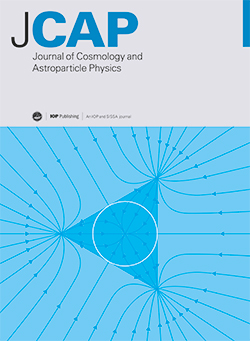Tomographic redshift dipole: testing the cosmological principle
IF 5.3
2区 物理与天体物理
Q1 ASTRONOMY & ASTROPHYSICS
Journal of Cosmology and Astroparticle Physics
Pub Date : 2024-09-29
DOI:10.1088/1475-7516/2024/09/077
引用次数: 0
Abstract
The cosmological principle posits that the universe is statistically homogeneous and isotropic on large scales, implying all matter shares the same rest frame. This principle suggests that velocity estimates of our motion from various sources should agree with the cosmic microwave background (CMB) dipole's inferred velocity of 370 km/s. Yet, for over two decades, analyses of radio galaxy and quasar catalogs have found velocities at odds with the CMB dipole, with tensions up to 5σ. In a blind analysis of BOSS and eBOSS spectroscopic data from galaxies and quasars across 0.2 < z < 2.2, we applied a novel dipole estimator for a tomographic approach, robustly correcting biases and quantifying uncertainties with realistic mock catalogs. Our findings with eBOSS data (0.6 < z < 2.2), indicating a velocity of 196+92-79-79 km/s, demonstrate a 2σ agreement with the CMB dipole when considering the full 3D vector distribution and a 3-to-6σ tension with previous number count studies. This result supports the cosmological principle, emphasizing the consistency of our motion with the CMB across vast cosmic distances. On the other hand, the BOSS data revealed potential unmodeled systematics; the estimator could not be minimized using the LOWZ set (0.2 < z < 0.4), and the CMASS set (0.4 < z < 0.6) presented results that pointed towards the southern hemisphere, conflicting with the CMB dipole. Addressing the disparities with earlier number count analyses and understanding possible systematics in spectroscopic measurements will be essential to further validate the cosmological principle.断层红移偶极:检验宇宙学原理
宇宙学原理认为,宇宙在大尺度上是统计均匀和各向同性的,这意味着所有物质共享同一个静止框架。根据这一原理,各种来源对我们运动速度的估计应该与宇宙微波背景(CMB)偶极子推断的 370 千米/秒的速度一致。然而,二十多年来,对射电星系和类星体目录的分析发现,我们的运动速度与 CMB 偶极子的速度不一致,张力高达 5σ。在对来自0.2 < z < 2.2的星系和类星体的BOSS和eBOSS光谱数据的盲分析中,我们应用了一种新的层析方法偶极子估计器,利用现实的模拟星表稳健地校正了偏差并量化了不确定性。我们对 eBOSS 数据(0.6 < z < 2.2)的研究结果表明速度为 196+92-79-79 km/s,当考虑到完整的三维矢量分布时,与 CMB 偶极子的吻合度为 2σ,与之前的数量计数研究的吻合度为 3-6σ。这一结果支持宇宙学原理,强调了我们的运动在广阔的宇宙距离上与 CMB 的一致性。另一方面,BOSS数据揭示了潜在的未建模系统性;使用LOWZ集(0.2 < z < 0.4)无法最小化估计值,而CMASS集(0.4 < z < 0.6)的结果指向南半球,与CMB偶极相冲突。要进一步验证宇宙学原理,就必须解决与早期计数分析之间的差异,并了解光谱测量中可能存在的系统性。
本文章由计算机程序翻译,如有差异,请以英文原文为准。
求助全文
约1分钟内获得全文
求助全文
来源期刊

Journal of Cosmology and Astroparticle Physics
地学天文-天文与天体物理
CiteScore
10.20
自引率
23.40%
发文量
632
审稿时长
1 months
期刊介绍:
Journal of Cosmology and Astroparticle Physics (JCAP) encompasses theoretical, observational and experimental areas as well as computation and simulation. The journal covers the latest developments in the theory of all fundamental interactions and their cosmological implications (e.g. M-theory and cosmology, brane cosmology). JCAP''s coverage also includes topics such as formation, dynamics and clustering of galaxies, pre-galactic star formation, x-ray astronomy, radio astronomy, gravitational lensing, active galactic nuclei, intergalactic and interstellar matter.
 求助内容:
求助内容: 应助结果提醒方式:
应助结果提醒方式:


